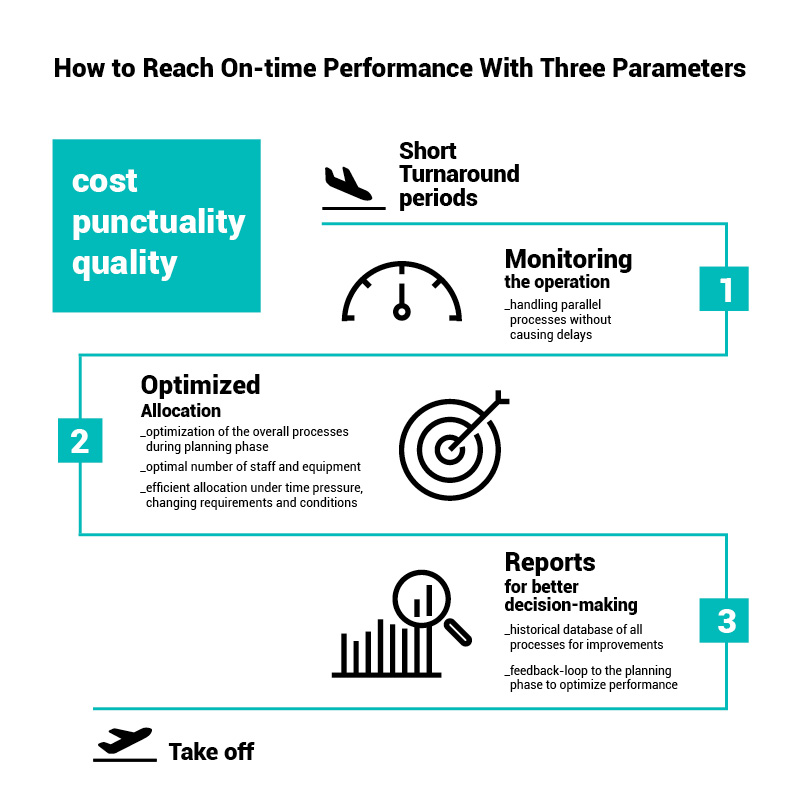“On-Time Performance is not an option, it’s mandatory!” You want to see a clear illustration of why? Compare the Formula 1 Pit Stop times in 1950, it took way longer than a minute, a short coffee break by today’s standards. In 2013: just under three seconds.
In the last decades, the aviation business has experienced a very similar development. The turnaround periods have become shorter while the amount of processes to be executed during this period have increased at the same time. And, while at Formula 1 it’s mainly about being fast, the airlines must find a tight balance amongst the success factors of cost effectiveness, punctuality and quality. Finding this balance is a complex task which needs to be carried out thousands of times every day. Our take-away to address this challenge is to find the right balance between these three factors, depending on the targeting and orientation of the respective airline.
Monitoring the operation
What does monitoring have to do with On-Time Performance? Monitoring in this respect follows the “management by exception” approach. While hundreds of processes are carried out in parallel, it is simply not possible to stay on top of every single one. The dispatcher needs to focus on the processes that need attention because they might cause delays, or the ones that are already critical and need immediate action. A well-arranged GUI helps as it includes all relevant information including the stakeholder of the process (e.g. the cabin cleaning) as well as the respective delay.
Optimized allocation
The second step that needs to be taken is the optimization of the overall processes. This doesn´t start at the day of operations when the dispatcher comes to work. To do so, an ideal resource coverage must be maintained. The planning phase is an important piece in this complex puzzle. After calculating the optimal number of staff and equipment their workloads need to be created, tightly based on the flight schedule and optimized based on rules and parameters. Shift model optimizations are driven by current demand.
The allocation on the day of operations needs to be very agile to meet the ever-changing requirements and conditions. There are hundreds of tasks that need to be managed and changed whenever there are disruptions. To support them, regulation-compliant tasks need to be created automatically. Given this time pressure, an efficient, and ideally real-time communication between all parties is a key factor for a smooth operation. Through mobility functionalities and web applications, orders today can be forwarded to the agents, who are notified by mobile alerts in real-time. In turn, they can respond their status updates – like confirmed, started, finished, delayed – to the system. This minimization of voice communication results in highly increased productivity as staff members can concentrate on their key tasks.
Staff is important, but don´t forget the equipment: To ensure the availability of the Ground Support Equipment (GSE), the status and location needs to be constantly monitored. One important side fact: beside the efficiency, technical failures can put the safety of staff and passengers at risk.
Reports for better decision-making
However smooth and effective the processes may be: nothing is perfect in the world of aviation. All processes need to undergo continuous improvements. To decide what needs to be changed, it’s helpful to have a historical database – the third parameter in the business.
The management level is particularly interested in this third parameter. The initial plan is compared to the actual operation which provides a feedback-loop to the planning phase. The performance of staff and suppliers is analyzed to optimize their potential use. But all these reports don´t have an impact on the operation if they are not distributed to the right people. The solution: dashboards and reports need to deliver figures to support the creation of relevant KPI’s and the automatic distribution to the right target groups. Depending on the history of the database, the reports can support operative, tactical and strategic decision-making processes.
Closing thoughts
It is likely that the developments toward a faster and more complex environment will continue. Business insiders confirmed the growing pressure to optimize processes, yet make them as agile as possible. It has shown once again: If you want to succeed in the market, you need the appropriate tools to achieve OTP and still maintain the desired balance between the mentioned core factors.







0 comments on “How To Reach On-Time Performance With Three Parameters”